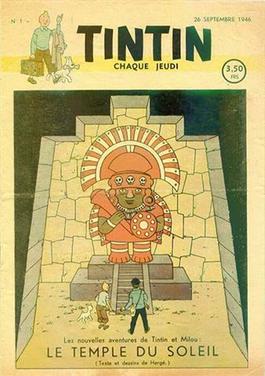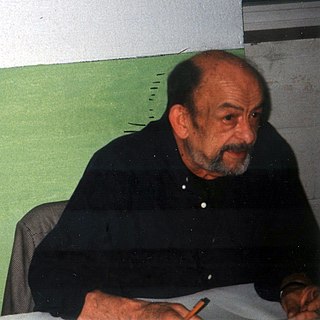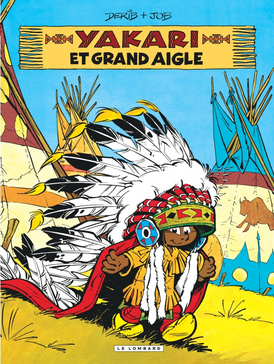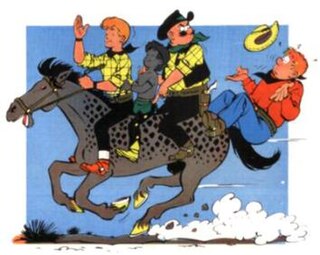
Hermann Huppen is a Belgian comic book artist. He is better known under his pen-name Hermann. He is most famous for his post-apocalyptic comic Jeremiah which was made into a television series.

Philippe Vandevelde, working under the pseudonym Tome, was a Belgian comics writer. He was known for collaborations with Janry on Spirou et Fantasio and Le Petit Spirou, and with Luc Warnant and later Bruno Gazzotti on Soda. He also collaborated with Ralph Meyer on Berceuse assassine, and with Marc Hardy on Feux. Earlier in his career he was an assistant-artist for Dupa.

Yoko Tsuno is a comics album series created by the Belgian writer Roger Leloup published by Dupuis in Spirou magazine since its debut in 1970. Through thirty volumes, the series tell the adventures of Yoko Tsuno, a female electrical engineer of Japanese origin surrounded by her close friends, Vic Video and Pol Pitron. Their adventures bring them to, among other places, Belgium (Bruges), Germany, Scotland, Japan, Hong Kong, Indonesia and also into outer space. The stories are heavily technology driven, with concepts like robot dragons, suspended animation, time travel, and even an alien species called the Vineans. Despite the often exotic settings and science-fiction plot lines, the stories generally remain realistic on the personal level between the characters and friendship, love and spirituality are some of the key themes of the series. The art is drawn in Ligne claire style, although having originally started out in the Marcinelle style. When depicting real-world settings, Leloup aspires to be as true to reality as possible, with places like Burg Katz or Rothenburg ob der Tauber depicted with almost photographic skill.

Blake and Mortimer is a Belgian comics series created by the writer and comics artist Edgar P. Jacobs. It was one of the first series to appear in the Franco-Belgian comics magazine Tintin in 1946, and was subsequently published in book form by Le Lombard.
Raymond Macherot was a Belgian cartoonist. Although not nearly as famous as fellow Belgian cartoonists such as Hergé or André Franquin, Macherot's work, both as artist and writer, remains highly regarded among critics and collectors.

Bob de Groot was a Belgian comic books artist and writer.
Le Lombard, known as Les Éditions du Lombard until 1989, is a Belgian comic book publisher established in 1946 when Tintin magazine was launched. Le Lombard is now part of Média-Participations, alongside publishers Dargaud and Dupuis, with each entity maintaining its editorial independence.

Cubitus is a Franco-Belgian comics series, and the basis for the Wowser cartoon series appearing in the United States. Cubitus was created by the Belgian cartoonist Dupa, and features Cubitus, a large anthropomorphic dog, who lives with his owner Semaphore. Cubitus is known as Dommel in Flanders and the Netherlands, Muppelo or Pom Pom in Finland, Teodoro in Italy, Zıpır in Turkey and Доммель in Russia. His name derives from the old anatomical name of the ulna bone, supposedly derived from the Greek kybiton (elbow).

Oumpah-pah le Peau-Rouge is a comics series created by comics artist Albert Uderzo and comics author René Goscinny, best known as the creators of Asterix. The series first appeared in the weekly Tintin magazine in 1958 though it remained serialised for a relatively short time, ending in 1962. The stories were published in book form by Lombard and Dargaud starting in 1961. In 1995, the series was reissued by Albert Uderzo's own publishing house, Les Éditions Albert-René.

Tintin was a weekly Franco-Belgian comics magazine of the second half of the 20th century. Subtitled "The Magazine for the Youth from 7 to 77", it was one of the major publications of the Franco-Belgian comics scene and published such notable series as Blake and Mortimer, Alix, and the principal title The Adventures of Tintin. Originally published by Le Lombard, the first issue was released in 1946, and it ceased publication in 1993.

Barelli is a comics series featuring an eponymous character, created by Bob de Moor, which first appeared in the Franco-Belgian comics magazine Tintin on July 27, 1950. Barelli made sporadic serial runs throughout the 1950s, 1960s and 1970s while 8 albums in the series were released by Lombard and Bédescope.

Paul Cuvelier was a Belgian comics artist best known for the comic series Corentin, published by Le Lombard, which first appeared in the first issue of Tintin magazine.

Willy Maltaite, better known by the pseudonym Will, was a Belgian comics creator and comics artist in the Franco-Belgian tradition. In the genre known in Francophone countries as bande dessinée, Will is one of the young cartoonists trained by Jijé, who made them live and work with him in his studio in Waterloo. He is considered one of la Bande des Quatre, and a founding member of the Marcinelle school.

Zig et Puce is a Franco-Belgian comics series created by Alain Saint-Ogan in 1925 that became popular and influential over a long period. After ending production, it was revived by Greg for a second successful publication run.

Yakari is a Franco-Belgian comic book series, aimed at a younger audience, originally written by Job, and illustrated by Derib, both from Switzerland. The series is now written by Frenchman Joris Chamblain.

Chick Bill is a Belgian humorous Western comic book series created by Tibet. It was first published in 1953 in the magazine Chez Nous Junior, and its Dutch language counterpart Ons Volkske, and began serial publication on October 19, 1955, in Tintin magazine under the title Les aventures de Chick Bill le cow-boy. 70 books of the series were published, and it lasted until Tibet's death in 2010. Tibet wrote many of the scripts as well as drawing all the episodes, but various stories were written by André-Paul Duchâteau and Greg and one episode was scripted by René Goscinny. Frank Brichau was credited as co-illustrator for the last two books.

Tibet, the pseudonym of Gilbert Gascard, was a French cartoonist in the Franco-Belgian comics tradition. Tibet, who debuted in 1947, is known for work produced for the Franco-Belgian comics magazine Tintin, most notably the long-running series Ric Hochet and Chick Bill.

Bruno Brazil is a Franco-Belgian comics series written by Greg, under the pseudonym Louis Albert, and drawn by William Vance. It was initially serialised in the Franco-Belgian comics magazine Tintin, first appearing on January 17, 1967. The first album publication was in 1969, while the latest album was first published in 1995. While Dargaud had initially published the series up to the penultimate volume, the rights were eventually passed on to Le Lombard, which is part of the same holding company, Média-Participations, and the final volume was published under its banner. As of today, the series is yet to be published in English but is available in various other languages, including French and Spanish.
L'Élève Ducobu is a comic series created by Zidrou (scenario) and Godi (drawing). The series tells the adventures of Ducobu, a comic and eccentric dunce. The series first appeared in September, 1992, in the Belgian comics magazine Tremplin. The first album was published in 1997 by Le Lombard and from this year have appeared in the French comics magazine Le Journal de Mickey.

Chlorophylle was a Belgian comics series and Raymond Macherot's best known work, alongside Sibylline. It is a fantasy comic about anthropomorphic forest animals, including the title character Chlorophylle, who is a dormouse.


















